JBL SUB-500 Service manual
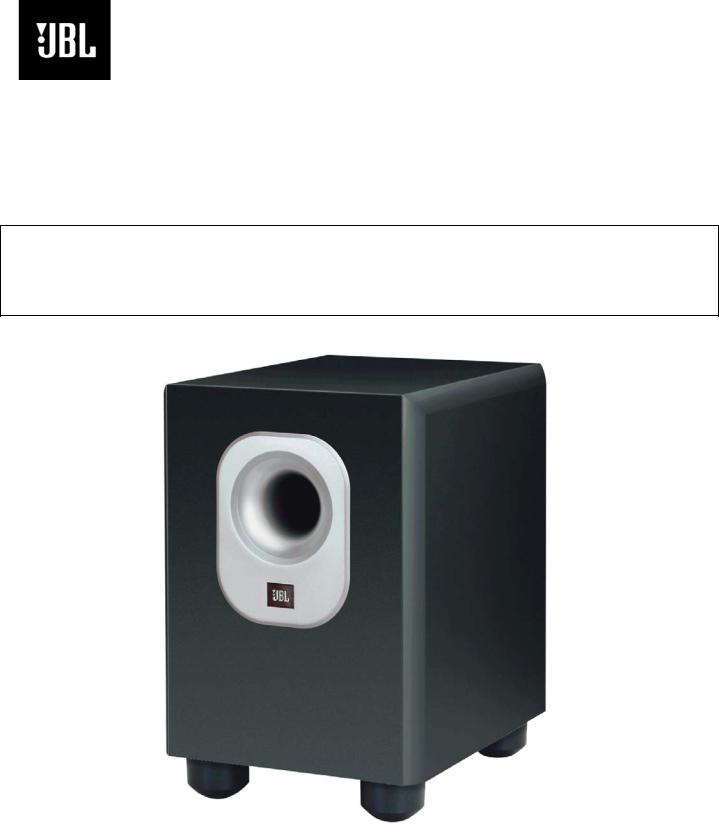
Surround Cinema
SUB500
Amplifier/Subwoofer
SERVICE MANUAL
JBL Consumer Products
250 Crossways Park Dr.
Woodbury, New York |
11797 |
Released 2007 |
Rev0 6/2007 |
Discontinued XXXX |
|
Note: The SUB500 is part of the SCS500.5 system
Satellite loudspeakers SCS500SAT: order JBL part# SCS500BK SAT-E Center channel SCS500CEN: order JBL part# SCS500BK CEN-E
- CONTENTS -
BASIC SPECIFICATIONS……………….….….….….…………….1 DETAILED SPECIFICATIONS ……..…………….……………..2 PACKAGING/ACCESSORIES……..…………….………………..4 CONNECTIONS..………………………..………….…….………...5 OPERATION ………….……………………………..…………….6
BASIC TROUBLESHOOTING…..…………….….….…….……...6 TEST SET-UP AND PROCEDURE……………………………….7 EXPLODED VIEW/PARTS LIST…………………………………..8 BLOCK DIAGRAM………………….…………………………........9 PCB DRAWINGS………………..………………………………...10 120V ELECTRICAL PARTS LIST ………………..……………..12 230V ELECTRICAL PARTS LIST …………………..…………..15 INTEGRATED CIRCUIT/TRANSISTOR PINOUTS.................18 120V SCHEMATICS.………..……………….….………. ………19
230V SCHEMATICS.………..……………….…….……. ………22
SUB500 BASIC SPECIFICATIONS
Amplifier Output |
150 Watts RMS |
Frequency Response |
30Hz – 120Hz (–6dB) |
Woofer |
10" (254mm) |
Enclosure |
Bass-reflex |
Dimensions (H x W x D) |
20" x 13-3/4" x 15-3/4" (508mm x 349mm x 400mm) |
(including feet) |
|
Weight |
35 lb (15.9kg) |
Occasional refinements may be made to existing products without notice but will always meet or exceed original specifications unless otherwise stated
1
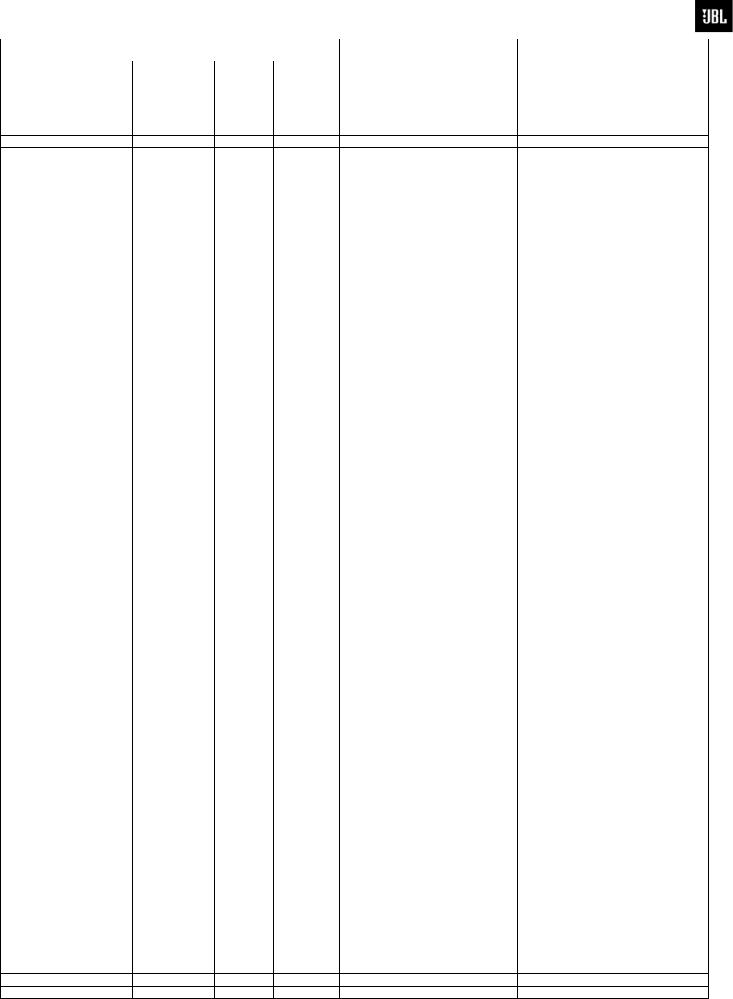
SUB500 (SCS500.5 Subwoofer) |
|
|
|
|
||
|
|
|
|
|
|
|
JBL SUB 500 150W Powered Sub/ Plate Amp |
|
|
|
|||
|
|
|
|
|
|
|
LINE VOLTAGE |
Yes/No |
Hi/Lo Line |
Unit |
Notes |
|
|
US 120VAC/60Hz |
Yes |
108-132 |
Vrms |
Normal Operation |
|
|
Asia 100VAC/50Hz |
Yes |
90-110 |
Vrms |
Normal Operation |
|
|
EU 230VAC/50-60Hz |
Yes |
207-264 |
Vrms |
Normal Operation |
Normal operation, MOMS required |
|
|
|
|
QA Test |
|
|
Parameter |
Specification |
Unit |
Limits |
Conditions |
Notes |
Amp Section |
|
|
|
|
|
Type (Class AB, D, other) |
D |
D |
N/A |
|
|
Load Impedance (speaker) |
4 |
Ohms |
N/A |
Nominal |
|
Rated Output Power |
150 |
Watts |
140 |
1 input driven |
|
THD@ Rated Power |
0.5 |
% |
1 |
22KHz filter |
|
THD @ 1 Watt |
0.1 |
% |
0.3 |
22KHz filter |
|
DC Offset |
10 |
mV-DC |
50 |
@ Speaker Outputs |
|
|
|
|
|
|
Measured at speaker terminals, Output |
Damping factor |
>100 |
DF |
30 |
|
power 140 Watts THD 0.1 % |
|
|
|
|
|
|
Input Sensitivity |
|
|
|
|
|
Input Frequency |
50 |
Hz |
50 |
Nominal Freq. |
1 input driven |
Line Input (L&R) |
250 |
mVrms |
±2dB |
To rated power |
1 input driven |
LFE Input |
145 |
mVrms |
±2dB |
To rated power |
LFE input driven only |
Speaker/Hi Level Input |
2.5 |
Vrms |
±2dB |
To rated power |
(-20 dB below Line In)...1 input driven |
|
|
|
|
|
|
Signal to Noise |
|
|
|
|
|
SNR-A-Weighted |
100 |
dBA |
85 |
rel. to rated power |
A-Weighting filter |
SNR-unweighted |
90 |
dBr |
80 |
rel. to rated power |
22KHz filter |
SNR @ 1W-unweighted |
60 |
dBr |
55 |
rel. to 1W Output |
22KHz filter |
|
|
|
|
Volume @max, using RMS reading |
|
Residual Noise Floor |
1 |
mVrms |
2 |
DMM/VOM (or A/P) |
|
|
|
|
|
Volume @max, w/ A/P Swept |
|
|
|
|
|
Bandpass Measurement (Line freq.+ |
|
Residual Noise Floor |
1 |
mVrms(max) |
2 |
harmonics) |
|
|
|
|
|
|
|
Input Impedance |
|
|
|
|
|
Line input L&R , LFE |
>10 |
K ohms |
N/A |
Nominal |
|
Speaker/Hi Level Input |
4.7 |
K ohms |
N/A |
Nominal |
|
|
|
|
|
|
|
Filters |
|
|
|
|
|
Left & Right Low Pass fixed |
Hz |
-- |
±2dB |
|
|
Slope & Q |
4th |
dB/Octave |
N/A |
|
|
LFE Low Pass fixed |
Hz |
-- |
±2dB |
|
|
Slope & Q |
2nd |
dB/Octave |
N/A |
|
|
Subsonic filter (HPF) |
Hz |
-- |
±2dB |
|
|
Slope & Q |
2nd |
dB/Octave |
N/A |
|
|
|
|
|
|
|
|
Limiter (yes/no) |
YES |
-- |
N/A |
|
|
THD at Max. Output Power |
N/A |
-- |
N/A |
|
|
|
|
|
|
|
|
Features |
|
|
|
|
|
LFE Input |
YES |
|
functional |
|
BW Limited to 500 Hz |
Volume pot Taper (lin/log) |
log |
-- |
functional |
|
|
ATO |
YES |
|
functional |
|
|
|
|
|
|
|
|
Input Configuration |
|
|
|
|
|
Line In (L,R) |
L ,R |
-- |
functional |
|
RCA inputs: L , R Summed to Mono |
Line level in LFE |
LFE |
|
functional |
|
|
Spkr/Hi Level In (L,R) |
L,R |
-- |
functional |
|
L R Summed to Mono |
Spkr Out: Level out (L,R)Hi P |
L,R |
|
functional |
|
Direct by pass from Speaker in |
|
|
|
|
|
|
Signal Sensing (ATO) |
|
|
|
|
|
ATO test Frequency |
50 |
Hz |
functional |
|
|
|
|
|
|
2mV@50Hz into Line Input w/ 1 ch. |
|
ATO Line Level |
2 |
mV |
functional |
driven |
|
|
|
|
|
50mV@50Hz into Line Input w/ 1 ch. |
|
ATO Speaker level input |
50 |
mV |
fucntional |
driven |
|
|
|
|
|
Amp connected and AC on, then input |
|
ATO Turn-on time |
5 |
ms |
functional |
signal applied |
|
|
|
|
|
T before muting, after signal is |
|
Auto Mute/ Turn-OFF Time |
15 |
minutes |
functional |
removed |
Auto turn of time (T) must be 10 > T <15 |
2

SUB500 (SCS500.5 Subwoofer)
|
|
|
|
QA Test |
|
|
|
|
Parameter |
Specification |
Unit |
Limits |
Conditions |
Notes |
|
|
|
|
|
|
|
|
|
|
Power on Delay time |
3 |
sec. |
functional |
AC Power Applied |
|
|
|
|
|
|
|
|
|
|
|
Transients/Pops |
|
|
|
|
|
|
|
ATO Transient |
5 |
mV-peak |
10 |
@ Speaker Outputs |
|
|
|
Turn-on Transient |
50 |
mV-peak |
100 |
@ Speaker Outputs |
AC Line cycled from OFF to ON |
|
|
Turn-off Transient |
50 |
mV-peak |
100 |
@ Speaker Outputs |
AC Line cycled from ON to OFF |
|
|
|
|
|
|
|
|
|
|
Efficiency |
|
|
|
|
|
|
|
|
|
|
|
|
Maximum allowable input power under |
|
|
|
|
|
|
|
nominal Input voltage and frequency, |
|
|
Stand-by Input Power |
14 |
Watts |
15 |
@ nom. line voltage |
HOT or COLD operation. |
|
|
Power Cons.@rated power |
250 |
Watts |
260 |
@ nom. line voltage |
150 Watts @ 4 Ohms nominal line voltage |
|
|
|
|
|
|
|
|
|
|
Protection |
|
|
|
|
|
|
|
Short Circuit Protection |
YES |
-- |
functional |
Direct short at output |
|
|
|
|
|
|
|
|
Temperature rise should not exceed 35K |
|
|
Thermal Protection |
65 deg. C |
-- |
functional |
@1/8 max unclipped Power |
rise |
|
|
|
|
|
|
|
Relay or crowbar (for driver/fire |
|
|
DC Offset Protection |
YES |
-- |
functional |
DC present at Speaker Out leads |
protection) |
|
|
Line Fuse Rating |
|
|
|
|
|
|
|
|
|
|
|
|
External fuse with UL/SEMKO rated |
|
|
US Version |
2.5 |
Amps |
|
Type-T or Slo Blo |
holder |
|
|
|
|
|
|
|
External fuse with UL/SEMKO rated |
|
|
EU Version |
1.6 |
Amps |
|
Type-T or Slo Blo |
holder |
|
3
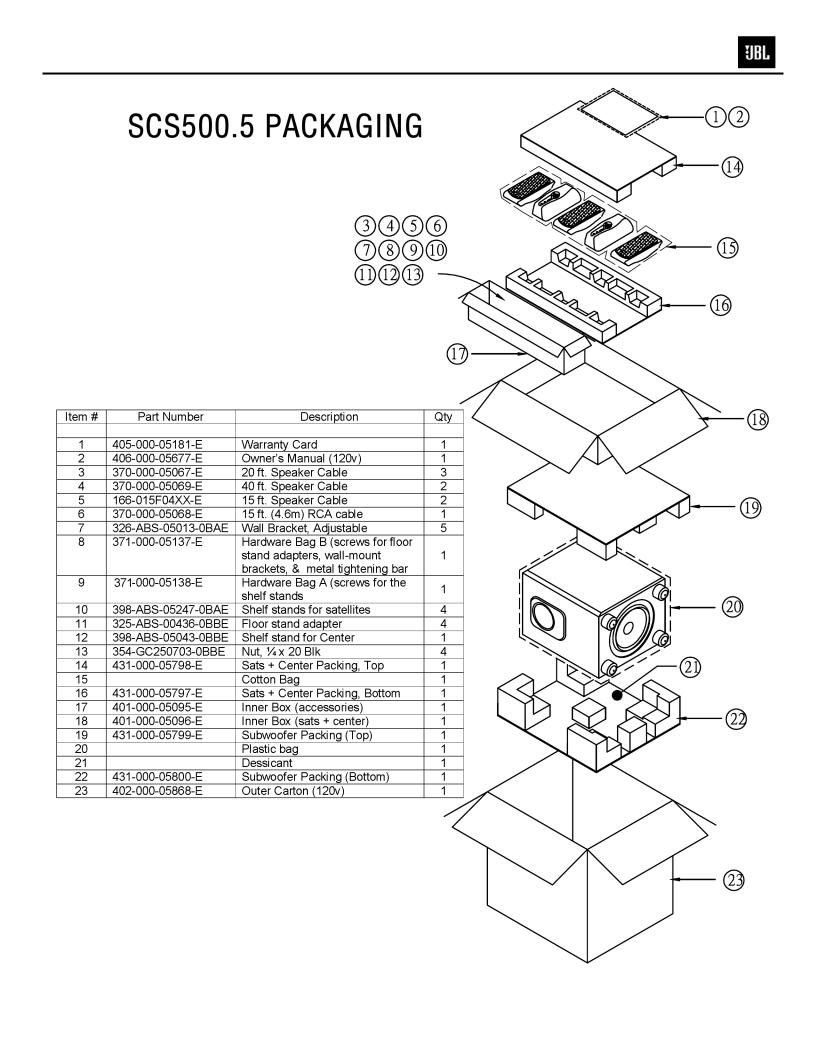
SUB500 (SCS500.5 Subwoofer)
4
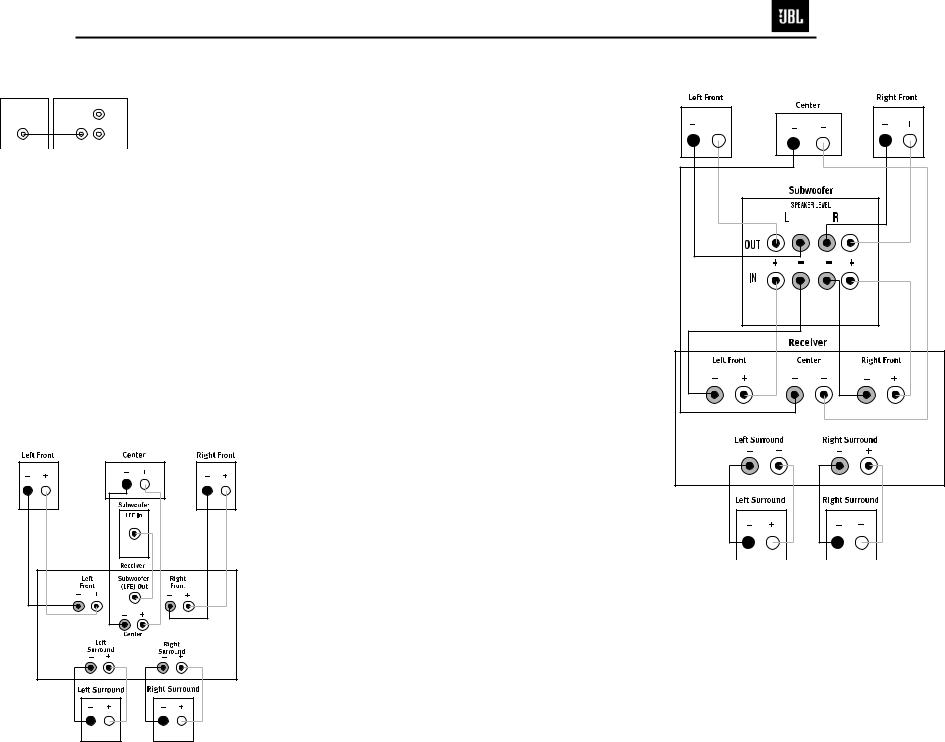
SUB500 (SCS500.5 Subwoofer)
DOLBY® DIGITAL OR DTS®
(OR OTHER DIGITAL SURROUND MODE) CONNECTION
RECEIVER SUBWOOFER
L
LFE OUT LINE LFE
LEVEL
IN
R
Use this installation method for Dolby Digital, DTS or other digital surround processors:
Use the line-level input jack marked “LFE” for the Low-
Frequency Effects channel. Connect this jack to the LFE output or subwoofer output on your receiver or amplifier. Connect each speaker to the corresponding speaker terminals on your receiver or amplifier.
Make sure that you have configured your surround sound processor for “Subwoofer On.” Also configure
your receiver for 5.1-channel operation, as appropriate. The front left, front right, center and surround speakers should all be set to “Small.” If your receiver allows you to set the crossover frequency between the subwoofer and the main speakers, select 100Hz or the setting that is the closest frequency below it.
® (NON-DIGITAL) – LINE LEVEL
Use this installation method for Dolby Pro Logic applications (not Dolby Digital, DTS or other digital processing), where the receiver/processor is equipped with a subwoofer output, or a volumecontrolled preamp (line-) level output:
Use RCA-type interconnects to connect the line-level subwoofer outputs on your receiver or amplifier to the line-level inputs on the subwoofer. IMPORTANT: Do not use the LFE input on the subwoofer with Dolby Pro Logic processors.
NOTE: If your receiver or amplifier only has one subwoofer output jack, then you will need to use a Y-connector (not included). Plug the male end of the Y-connector into your receiver or amplifier’s subwoofer output jack, and connect each of the two female ends to separate RCA-type interconnects. Finally, plug the RCA-type interconnects into the linelevel inputs on the subwoofer.
Connect each speaker to the corresponding speaker terminals on your receiver or amplifier.
Make sure your receiver or processor is correctly configured to indicate that the subwoofer is “On.”
Note for advanced users: If your receiver/processor has a built-in low-pass crossover filter for the subwoofer output, you may use the LFE input to bypass the subwoofer’s internal crossover.
DOLBY PRO LOGIC (NON-DIGITAL) – SPEAKER LEVEL
Use this installation method for Dolby Pro Logic applications (not Dolby Digital, DTS or other digital processing), where the receiver/processor does not have a subwoofer output, or a volume-controlled preamp (line-) level output:
Connect your receiver or amplifier’s front left and right speaker terminals to the left and right terminals on the subwoofer that are marked “Speaker Level In.” Connect the left and right terminals on the subwoofer that are marked “Speaker Level Out” to the corresponding terminals on the back of your front left and right speakers.
Connect your receiver or amplifier’s center, surround and surround back speaker terminals to the corresponding terminals on the back of your center and surround speakers.
5
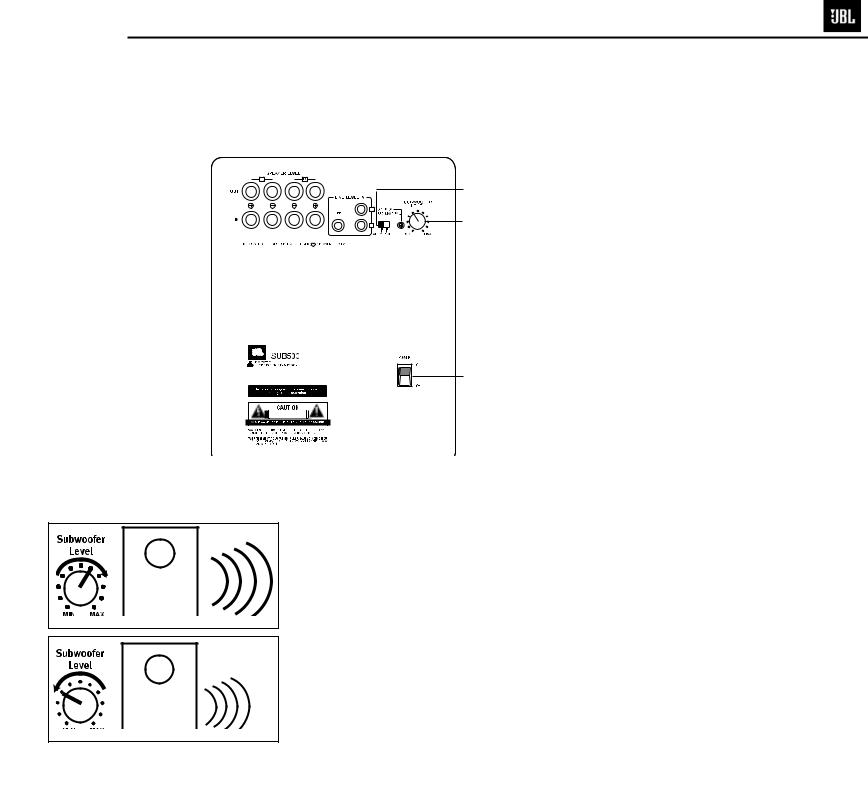
SUB500 (SCS500.5 Subwoofer)
OPERATION |
TROUBLESHOOTING |
Move the Master Power switch (marked “Power” å) to the “•” (On) position to use the subwoofer. The SUB500 subwoofer will automatically turn on or go into standby (sleep) mode when left in the auto mode (“Auto/On” switch çin the “Auto” position). When your receiver or amplifier is off, or is not sending program material to the subwoofer, the subwoofer will be in standby mode (LED will be red). When the subwoofer senses an audio signal, it will automatically turn on (LED will be green). If the subwoofer does not sense a signal after approximately 20 minutes, it will automatically go into standby mode.
When the “Auto/On” switch ç is switched to the “On” position, the subwoofer will remain on, whether or not program material is playing.
If you will be away from home for an extended period of time, or if the subwoofer will not be used, switch the Master Power switch åto the Off position.
ç
∫
å
CAUTIO N
VOLUME
Volume may be adjusted using the Subwoofer Level control ∫ as shown.
If there is no sound from any of the speakers:
•Check that receiver/amplifier is on and a source is playing.
•Check that the powered subwoofer is plugged in, and its Power switch å is switched on (“•” position).
•Check all wires and connections between receiver/ amplifier and speakers. Make sure all wires are connected. Make sure none of the speaker wires are frayed, cut or punctured, or touching each other.
•Review proper operation of your receiver/amplifier.
If there is no sound coming from one speaker:
•Check the “Balance” control on your receiver/amplifier.
•Check all wires and connections between receiver/ amplifier and speakers. Make sure all wires are connected. Make sure none of the speaker wires are frayed, cut or punctured, or touching each other.
•In Dolby Digital or DTS modes, make sure that the receiver/processor is configured so that the speaker in question is enabled.
•Turn off all electronics
and switch the speaker in question with one of the other speakers that are working correctly. Turn everything back on, and determine whether the problem has followed the speaker, or has remained in the same channel. If the problem is in the same channel, the source of the problem is most likely with your receiver or amplifier,
and you should consult the
6
owner’s manual for that product for further information. If the problem has followed the speaker, consult your dealer for further assistance or, if that is not possible, visit www.jbl.com.
If there is no sound from the center speaker:
•Check all wires and connections between receiver/ amplifier and speaker. Make sure all wires are connected. Make sure none of the speaker wires are frayed, cut or punctured, or touching each other.
•If your receiver/processor is set in Dolby Pro Logic mode, make sure the center speaker is not in phantom mode.
•If your receiver/processor is set in one of the Dolby Digital or DTS modes, make sure the receiver/processor is configured so that the center speaker is enabled.
If the system plays at low volumes but shuts off as volume is increased:
•Check all wires and connections between receiver/ amplifier and speakers. Make sure all wires are connected. Make sure none of the speaker wires are frayed, cut or punctured, or touching each other.
•If more than one pair of main speakers is being used, check the minimum impedance requirements of your receiver/amplifier.
If there is low (or no) bass output:
•Make sure the connections to the left and right “Speaker Inputs” have the correct polarity (+ and –).
•Make sure the subwoofer is plugged into an active
electrical outlet, and is turned on (Power switch å in the “•” position).
• In Dolby Digital or DTS modes, make sure your receiver/processor is configured so that the subwoofer and LFE output are enabled.
If there is no sound from the surround speakers:
•Check all wires and connections between receiver/ amplifier and speakers. Make sure all wires are connected. Make sure none of the speaker wires are frayed, cut or punctured, or touching each other.
•Review proper operation of your receiver/amplifier and its surround sound features.
•Make sure the movie or TV show you are watching is recorded in a surround sound mode. If it is not, check to see whether your receiver/amplifier has other
surround modes you may use.
•In Dolby Digital or DTS modes, make sure your receiver/processor is configured so that the surround speakers are enabled.
•Review the operation of your DVD player and the jacket of your DVD to make sure that the DVD features the desired Dolby Digital or DTS mode, and that you have properly selected that mode using both the DVD player’s menu and the DVD disc’s menu.
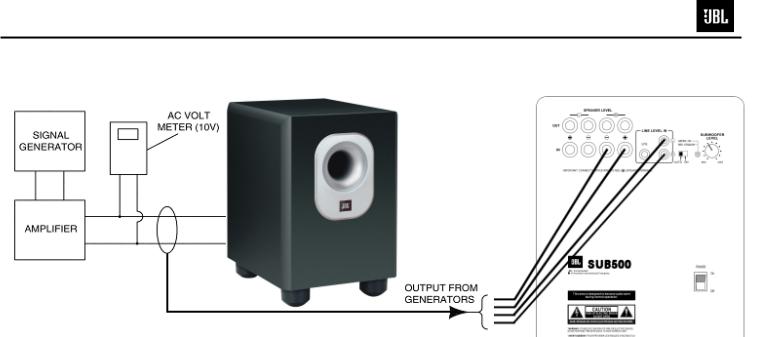
SUB500 (SCS500.5 Subwoofer)
SUB500 TEST PROCEDURE
SYSTEM AURAL SWEEP TEST
Equipment needed:
•Function/signal generator/sweep generator
•Integrated Amplifier
•Multimeter
•Speaker cables
General Unit Function (UUT = Unit Under Test)
Auto-On switch – either position
1)From the signal generator, Connect both right and left line level inputs (RCA) to signal generator and UUT. Use Y-cable if necessary from mono source. Do not use the LFE jack.
2)On the front of the unit, turn the LEVEL control full counterclockwise (MIN).
3)Turn on generator, adjust to 100mV, 50 Hz.
4)Plug in UUT; turn the power switch ON. Turn LEVEL control full clockwise (MAX)
5)LED should now be Green; immediate bass response should be heard and felt from port tube opening.
6)Turn off generator, turn LEVEL control fully counterclockwise (MIN), disconnect RCA cable.
7)Connect one pair of speaker cables to one pair Speaker Level input terminals on UUT. Cables should be connected to an integrated amplifier fed by the signal generator.
8)Turn on generator and adjust so that speaker level input at the amplifier is 2.0V, 50 Hz.
9)Turn LEVEL control full clockwise (MAX)
10)Green LED should light, immediate bass response should be heard and felt from the port tube opening.
Sweep Function
1)Follow steps 7-10 above, using a sweep generator as a signal source.
2)Sweep generator from 20Hz to 1kHz. Listen to the cabinet and drivers for any rattles, clicks, buzzes or any other noises. If any unusual noises are heard, remove woofer and test.
Driver Function (Woofer)
1)Remove woofer from cabinet; detach + and - wire clips.
2)Check DC resistance of woofer; it should be 3.4 ohms±10%.
3)Connect a pair of speaker cables to driver terminals. Cables should be connected to an integrated amplifier fed by a signal generator. Turn on generator and adjust so that speaker level output is 5.0V.
4)Sweep generator from 20Hz to 1kHz. Listen to driver for any rubbing, buzzing, or other unusual noises.
7
